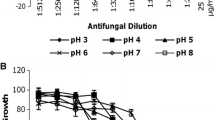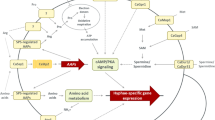Abstract
A combination of elevated temperatures (within the human febrile range) and trace metal chelation were investigated for their effects on the inhibition of growth and phenotypic development of the dimorphic yeast Candida albicans (strain 3153A). The ability of specific cations to relieve the phenotypic inhibition that occurred also was tested.
Elevated temperatures alone (to 41 °C) only delayed the timing of the phenotypic development. When compared to the results obtained at 37 °C, the recombination of elevated temperature and addition of the trace metal chelator, 1,10-phenanthroline, did not further suppress phenotypic development, but the combination did decrease the viability of C. albicans. When 24 to 48 h stationary phase singlet cells were released into a medium containing 100 μM 1,10-phenanthroline (pH 6.5), supplemental iron (200 μM) alleviated the suppression of mycelium formation at 41 °C, whereas under conditions favoring bud formation (pH 4.5), both iron and zinc circumvented suppression and promoted budding. Through studies on the interaction of temperature stress and trace metal availability our data revealed the requirement for iron mycelium formation whereas both iron and zinc may be needed for bud formation.
Similar content being viewed by others
References
Bedell G, Werth A, Soll DR: The regulation of nuclear migration and division during synchronous bud formation in released stationary phase cultures of the yeast Candida albicans. Exp Cell Res 127:103–113, 1980.
Bedell GW, Anderson RV: Inhibition of the differentiation of Candida albicans by the chelator 1,10-phenanthroline. (In press, Mycophathologia), 1985.
Bergeron RJ, Elliott GT, Kline SJ, Ramphal R, St. James III L: Bacteriostatic and fungostatic action of catecholamide iron chelators. Antimicrob agents and Chemotheraphy 24:725–730, 1983.
Buffo J, Herman MA, Soll DR: A characterization of pH-regulated dimorphism in Candida albicans. Mycopathologia. 85:21–30, 1984.
Caroline L, Taschdjian CL, Kozinn PJ, Schade AL: Reversal of serum fungistasis by addition of iron. J Invest Dermatol, 42:415–419, 1964.
Esterly NB, Brammar SR, Crounse RG: Relationship of transferrin and iron to serum inhibition of Candida albicans. J Invest Dermatol 49:437–442, 1967.
Holzberg M, Artis WA: Hydroxamate siderophore production by opportunistic and systemic fungal pathogens. Infect Immun 40:1134–1139, 1983.
King RD, Khan HA, Foye JC, Greenberg JH, Jones HE: Transferrin, iron and dermatophytes. I. Serum dermatophyte inhibitory component definitively identified as unsaturated transferrin. J Lab Clin Med 86:204–212, 1975.
Kluger MJ, Rothenburg BA: Fever and reduced iron: their interaction as a host defense response to bacterial infection. Science 203:374–376, 1979.
Krishnamurti C, Saryan LA, Petering DH: Effects of ethylenediaminetetraacetic acid and 1,10-phenanthroline on cell proliferation and DNA synthesis of Ehrlich ascites cells. Cancer Res 40:4092–4099, 1980.
Lee KL, Buckley HR, Campbell HR: An amino acid liquid synthetic medium for development of mycelial and yeast forms of Candida albicans. Sabouraudia 13:148–153, 1975.
Mitchell LH, Soll DR: Commitment to germ tube or bud formation during release from stationary phase in Candida albicans. Exp Cell Res 120:167–179, 1979.
Odds FC: Candida and Candidosis. Univ Park Press, Baltimore, 1979.
Rodbard DH, Wachslicht-Rodbard H, Rodbart S: Temperature: A critical factor determining localization and natural history of infectious, metabolic, and immunological diseases. Perspect Biol Med 23:439–474, 1980.
Schulman A, Dwyer FP: Metal chelators in biological systems, pp. 383–439. In: Dwyer FP, Mellor DP (eds), Chelating Agents and Metal Chelates. Academic Press, NY, 1964.
Soll Dr, Bedell G: Bud formation and the inducibility of pseudo-mycelium outgrowth during release from stationary phase in Candida albicans. J Gen Micro 108:173–180, 1978.
Soll DR, Stasi M, Bedell G: The regulation of nuclear migration and division during pseudo-mycelium outgrowth in the dimorphic yeast Candida albicans. Exp Cell Res 127:103–113, 1978.
Soll DR, Bedell GW, Brummel M: Zinc and the regulation of growth and phenotype in the infectious yeast Candida albicans. Infect Immun 32:1139–1147, 1981.
Soll DR, Bedell G, Thiel J, Brummel M: The dependency of nuclear division on volume in the dimorphic yeast Candida albicans. Exp Cell Res 133:55–62, 1981.
Trowbridge IS, Lesley J, Schlute R: Murine cell surface transferrin receptor: studies with an anti-receptor monoclonal antibody. J Cell Physiol 112:403–410, 1982.
Weinberg ED: Roles of temperature and trace metal metabolism in host pathogen interactions, pp. 241–260. In Hoekstra, Suttie, Ganther, and Mertz (eds), Trace Element Metabolism in Animals-2. Univ Park Press, Baltimore, 1974.
Weinberg ED: Nutritional immunity-Host's attempt to withhold iron from microbial invaders. JAMA 231:39–41, 1975.
Weinberg ED: Iron and infection. Microbiol Rev 42:45–66, 1978.
Author information
Authors and Affiliations
Rights and permissions
About this article
Cite this article
Ismail, A., Bedell, G.W. Effect of elevated temperatures and low levels of trace metals on the growth and phenotypic development of Candida albicans . Mycopathologia 94, 45–51 (1986). https://doi.org/10.1007/BF00437261
Issue Date:
DOI: https://doi.org/10.1007/BF00437261




